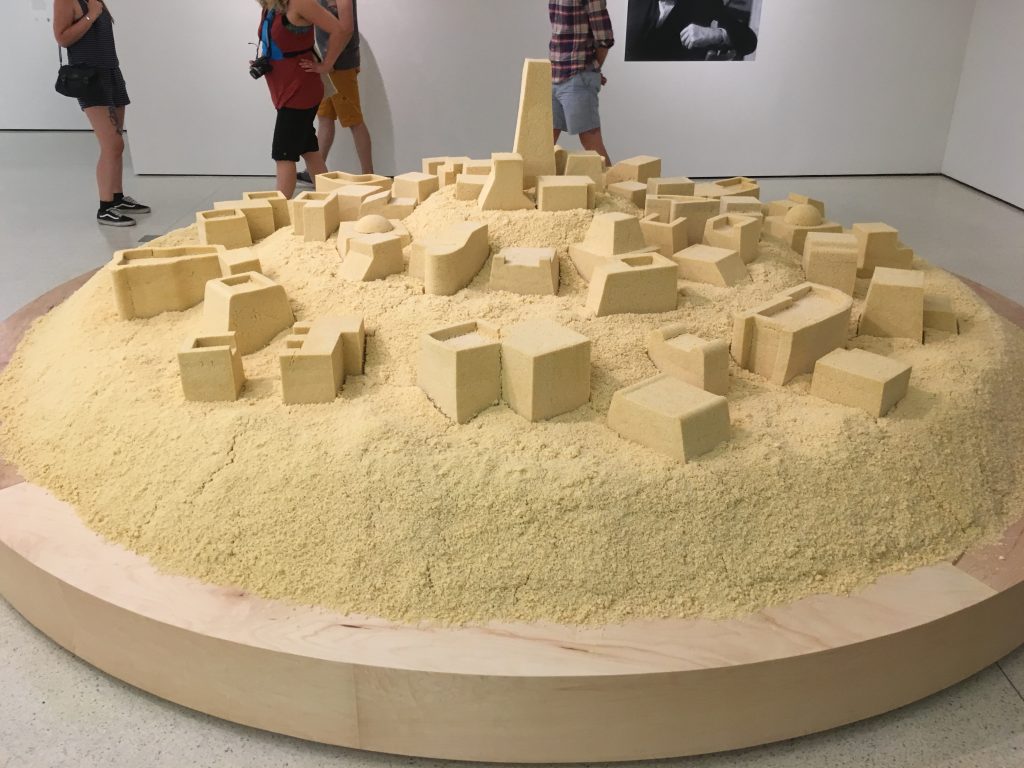
If you head over to The Guggenheim in New York City, you’re bound to spend time immersing yourself in the Moholy-Nagy exhibit that’s now on display. It’s well worth your time. You can also take a side trip through a smaller exhibition featuring the work of Middle Eastern and North African artists. And there you’ll discover the work of Kader Attia, a French-Algerian artist whose work “reflects on the impact of Western societies on their former colonial counterparts.” Above, we have Attia’s replica of an Algerian city (Ghardaïa) made out of couscous. The Tate explains the conceptual thrust of the piece as follows:
The installation presents a model of the Algerian town Ghardaïa made from cous cous, shown alongside photographs of the Swiss-born architect Le Corbusier and the French architect Fernand Pouillon, and a print of the UNESCO declaration that the town is a World Heritage site. During the nineteenth century Ghardaïa was colonised by France, but the buildings were not altered during this period and remain characteristic of Mozabite architecture. Le Corbusier visited Ghardaïa in 1931, just three years after becoming a French citizen, and made sketches of the buildings. These strongly resemble the style of modernist architecture he subsequently espoused in his treatise on urban planning, La cité radieuse.
That a noted French architect should take inspiration from an Algerian town may not seem significant, however, as Attia notes, ‘architecture has first to do with politics, with the political order.’ As Attia is a child of Algerian immigrants and grew up partly in a Parisian banlieue, this statement seems particularly resonant. The use of cous cous as the material to ‘build’ the model is appropriate as it will provide an approximation of the town’s decay over time throughout the exhibition, while representing one of the region’s most popular foods – now a staple of European cuisine.
By replicating the town as an architects’ model in this way Attia shows the impact of his native culture, which had operated as a non-powerful host to colonial France, on their old colonisers, who went on to play host to the artist and his family. As well as highlighting the cultural impact of the colonised onto the coloniser, reversing the normally reported direction of influence, this also reveals the complexity of hospitality between people and nations which often relates to dispossession and re-appropriation…
Attia’s couscous installation is also on display at The Tate. If you’re in London, pay them a visit.
If you would like to sign up for Open Culture’s free email newsletter, please find it here. It’s a great way to see our new posts, all bundled in one email, each day.
If you would like to support the mission of Open Culture, consider making a donation to our site. It’s hard to rely 100% on ads, and your contributions will help us continue providing the best free cultural and educational materials to learners everywhere. You can contribute through PayPal, Patreon, and Venmo (@openculture). Thanks!
Related Content:
The Guggenheim Puts Online 1600 Great Works of Modern Art from 575 Artists
Rijksmuseum Digitizes & Makes Free Online 210,000 Works of Art, Masterpieces Included
The National Gallery Makes 25,000 Images of Artwork Freely Available Online
Download 448 Free Art Books from The Metropolitan Museum of Art


Leave a Reply